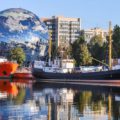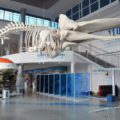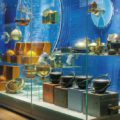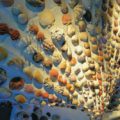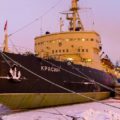The Kaliningrad region of Russia is far more than the coast of the Baltic Sea, cozy towns with ancient architecture, and the ruins of castles. It is also the center for study and preservation of maritime heritage, whose core is the Museum of the World Ocean — the only multi-dimensional maritime museum in Russia.
Welcome to the museum
Talking about the museum, the definition “multi-dimensional” seems a bit too matter-of-fact. However, it actually means that the museum covers a range of scientific areas. The Museum of the World Ocean has ships, which means it is a technical museum. It stores collections of sea mollusks shells and living fish, geological samples and sea charts, which means it is a natural science museum. The museum staff have collected tales about distant countries and amazing peoples, which refers to ethnography. The exposition tells its visitors about maritime history and building the fleet, and this is history. The museum vessels have preserved cabins, laboratories, and cockpits; thus, it can be called a memorial museum. It is also a museum of the icebreaker, naval, and fishing fleets and even astronautics. So, there is no surprise that the Museum of the World Ocean is a must-see for tourists and the most popular place among the locals. In 2021, over 1.2 million guests visited the city of Kaliningrad.
Preserve and demonstrate
There is only one quay of the historical fleet in Russia, and it was established in the Museum of the World Ocean. There are several vessels moored at the pier: the world’s largest research museum ship Vityaz; the country’s only Foxtrot-class submarine B-413, which is now a museum; Cosmonaut Viktor Patsaev — the only ship in the world designed for space communication, which now displays a museum exhibition; the only museum fishing vessel in the country SRT-129; the last manned floating lighthouse Irbensky built in Russia. This display of the historical fleet stretches as far as to St. Petersburg, where the world’s oldest icebreaker Krasin, a branch of the museum, is moored. The vessels represent the history of exploration and development of the World Ocean. Climb aboard ships, feel like an explorer, a submariner, or a member of the crew of a floating lighthouse, and listen to the voices of ships: the museum provides its guests with unforgettable experience.
The Depth exhibition in the main building of the museum tells the visitors about the study of the ocean. One can see barometers, current meters, hydrophysical probes, and deep-sea equipment. The main objects of the exposition are Mir-1 deep-sea manned submersible and one of the largest sperm whale skeletons in the world. The Mir devices designed under the scientific and technical guidance of the scientists and engineers at Shirshov Institute of Oceanology of the Russian Academy of Sciences, are real icons of oceanography. In 1991 and 1995, they were used to shoot movies on the legendary wreck of the Titanic at a depth of 3,800 meters. The Packgaus exhibition hall and the Naval Center present the history of the seaport and sea voyages.
In addition to this, the Museum of the World Ocean includes architectural monuments of the 19th century such as the Koenig Gate, which houses the Great Embassy historical and cultural center, and the Friedrichsburg Gate with the Ship’s Revival historical and cultural center. The staff of the museum reconstructed these monuments. The Royal Gates, the most striking gates of Kaliningrad, were renovated for the anniversary of Kaliningrad in 2005 with unbelievable speed and the highest quality. In the year of the 350th anniversary of Peter the Great, the preservation of the gates of the Friedrichsburg Fortress became the key priority. Peter the Great once visited it, and now the exhibition tells about the history of Russian shipbuilding and the travels of the young Russian emperor.
Ocean of projects
The ocean covers 70% of our planet. It plays an important role in climate regulation and supplies us with resources and energy. Therefore, international organizations pay great attention to ocean protection. In February 2022, the international summit One Ocean was held at the initiative of the UN and the President of the French Republic, Emmanuel Macron. The event focused on the topical issues of world maritime navigation and conservation of the oceans.
The UN declared the period from 2021 to 2030 the Decade of Ocean Science for Sustainable Development. The Museum of the World Ocean could not ignore this initiative and has developed two projects that will be implemented within this period. The first project is called “OCEAN&I School under Sail”. It aims to provide vocational guidance for young people, solve problems in the labor market, and provide career advice. The target audience of the project is teenagers aged 12–13. “OCEAN&I School under Sail” seeks to increase the number of applicants who want to do a maritime course, to educate young people, and to promote environmentally responsible attitude. The general partners of the program are the Marine Research Center of Moscow State University and Shirshov Institute of Oceanology of the Russian Academy of Sciences. The second approved project is the international scientific-practical conference “Issues of the Study and Preservation of the Marine Heritage”. The conference fasilitated the exchange of experience between the experts working on the study, conservation, and promotion of maritime heritage, the expansion of cooperation between museums and scientific organizations, the presentation of scientific results related to museum work, identification of pressing issues of marine heritage conservation and finding ways to solve them.
The museum is a media partner of the All-Russian Scientific Conference “The Seas of Russia: Challenges of Russian Science” hosted by the Marine Hydrophysical Institute of the Russian Academy of Sciences. This conference is an annual event held under the auspices of the Marine Board under the Government of the Russian Federation. For the second time, the Museum of the World Ocean is one of the organizers of the scientific forum. The conference aims to improve the coordination of marine research programs and the systems for monitoring the state of the seas, to conduct research, to adjust the planning of marine space, and to reduce marine risks. These measures will improve the management of marine and coastal resources.
Full ahead!
The Museum of the World Ocean not simply preserves buildings and ships, but it is growing steadily by including new objects. In 2020, the museum incorporated the lighthouse in the village of Zalivino that was built in 1908. Climbing the spiral staircase to the high brick tower, you can almost physically feel the vastness of the Curonian Lagoon, and the museum guides will tell you about the history of the lighthouse service and the job of a light-keeper. Nowadays the old lighthouse needs restoration. Fundraising has been launched for the restoration of this site of marine cultural heritage in cooperation with the Charitable Foundation “Municipal Improvement and Mutual Help”.
In addition to this, the museum is constructing a new exhibition building “Ocean Planet”. This huge sphere represents our planet as seen by astronauts. The facing of 1200 glasses is decorated with images of clouds, continents, seas, and oceans. Nine floors of exhibitions and use the most modern techniques to tell its visitors about the relationship of humans and their ancient and mysterious neighbor — the ocean.
One Ocean Summit enabled the discussion of the key issues related to ocean conservation. For instance, UNESCO Director-General Audrey Azoulay called for the intensification of seabed research as it plays crucial role in predicting tsunamis, identifying natural objects that need protection, and estimating fish resources for their sustainable use. “How can we succeed in protecting the ocean if we know so little about it? Only 20% of the seabed has been mapped. We need to go further and mobilize the international community so that at least 80% of the seabed is mapped by 2030,” said Ms Azoulay. The global seabed map should be created within the United Nations Decade of Ocean Science for Sustainable Development.
Courtesy of Museum of the World Ocean

